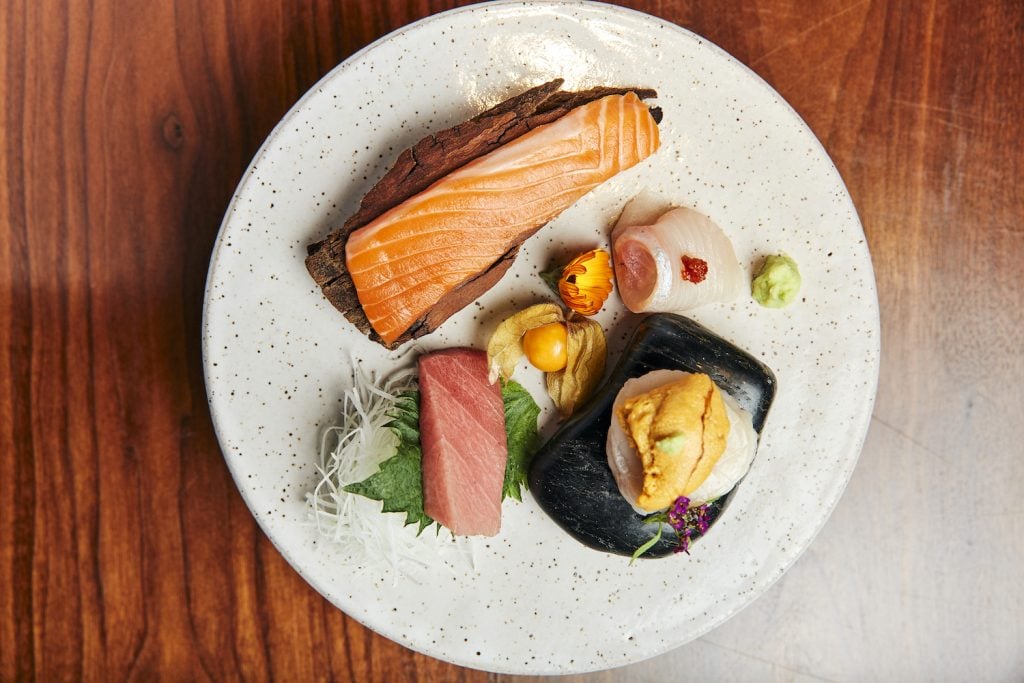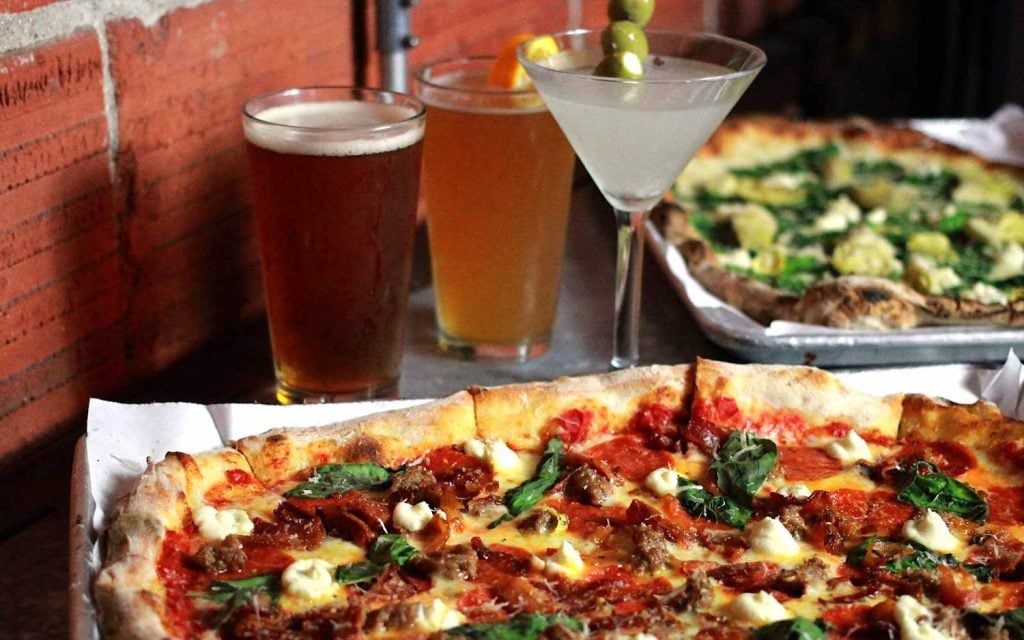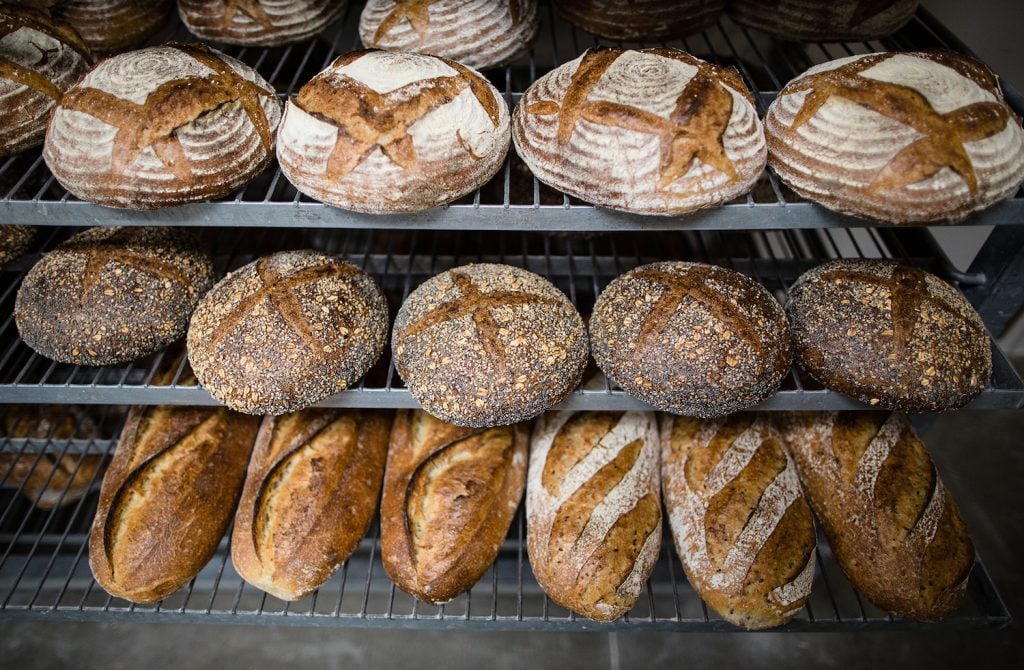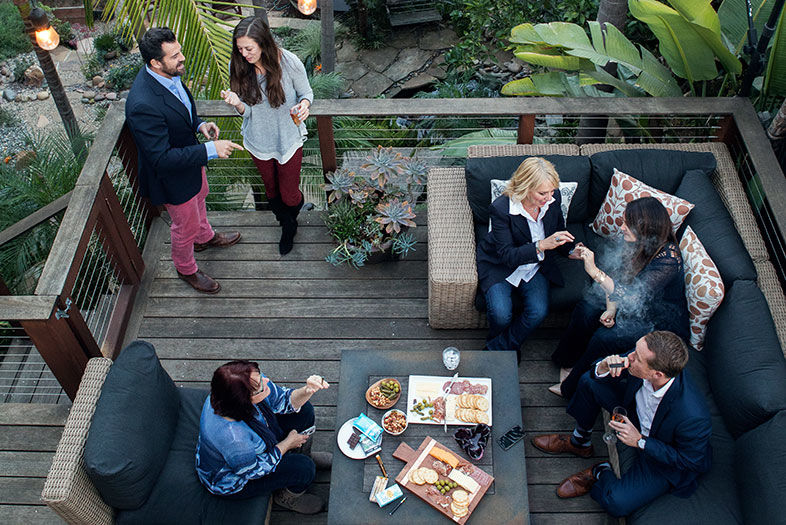It seems like a standard boardroom. A big table for big conversations. A small fridge with small waters. A flat-screen flips through striking photos of the company’s products. But then there’s that huge window. It doesn’t face outdoors; it’s an observation window. I look into the sepia-toned room below, and there they are. A couple hundred “babies,” as OutCo CEO Lincoln Fish calls them. “In six weeks, they’ll be six feet tall and the whole room will be green.”
Marijuana plants. Luscious, vibrant, emerald marijuana plants. Legal marijuana plants.
On January 1, recreational marijuana became legal in California. With a 56 percent yes vote, residents passed Prop 64 on November 8, 2016. Last September, the San Diego City Council voted 6-3 to go all-in—legalize and regulate marijuana cultivation, distribution, and retail—making it one of the most progressive cannabis cities in California.
Now the green rush is on. The state estimates legal weed sales could raise $7 billion a year in revenue by 2021, including $1 billion a year in taxes. When legal cannabis sales began in Colorado in 2014, it took only 10 months to sell $1 billion worth.
With that kind of revenue, you can hear potholes being filled, teachers getting raises, parks being cleaned. You can also hear parents doomsaying, the alcohol industry plotting revenge, and small marijuana farmers giving retirement speeches as corporations move in—like Privateer Holdings, a $150 million cannabis investment fund backed by PayPal founder Peter Thiel, or Constellation Brands, an alcohol distribution company that recently bought 10 percent of the Canadian marijuana market.
The History
How we got here is a long and winding road. The brief history of marijuana goes something like this, according to author Bruce Barcott in his book Weed the People. California first outlawed weed in 1913, when it was almost exclusively imported from Mexico. The Harrison Act of 1913 put control of narcotics under the purview of the federal government, but it concerned only cocaine and opiates. Harry Anslinger, the first commissioner of the Federal Bureau of Narcotics, didn’t initially want to go after marijuana. But then the Great Depression hit. His bureau was underfunded and in danger. Anslinger needed a cause to justify his organization’s existence. He convinced Congress that America was about to lose its soul to weed.
The Hearst newspaper empire helped, renowned as it was for making slight concerns into national moral panics. Its headlines included “Marijuana Makes Fiends of Boys in 30 Days” and the verbose “Murder Weed Found Up and Down Coast—Deadly Marihuana Dope Ready for Harvest that Means Mass Enslavement of California Children”.
Marijuana became enemy number one. Parents hid their children. This was ISIS, the plant.
But then the studies came. In 1925 the US Army commissioned lawyers, officers, and public and mental health professionals to study cannabis use by soldiers in Panama. The committee found no evidence that marijuana “has any appreciably deleterious influence on the individuals using it.” Fears of marijuana-fueled insanity “appear to have little basis in fact,” they went on.
Anslinger responded by making any such research into the drug illegal. Despite opposition from health officials, marijuana got lumped in with heroin and other hard drugs in the 1951 Boggs Act, a spat of hardline antidrug laws. As marijuana became the relaxant of choice for the antiwar hippie movement, it ruffled another powerful man: Richard Nixon. With the Comprehensive Drug Abuse Prevention and Control Act, he set out to separate drugs into five categories: The least harmful were given Schedule V, and the most harmful Schedule I. Cocaine and meth got Schedule II. Heroin and LSD landed in Schedule I.
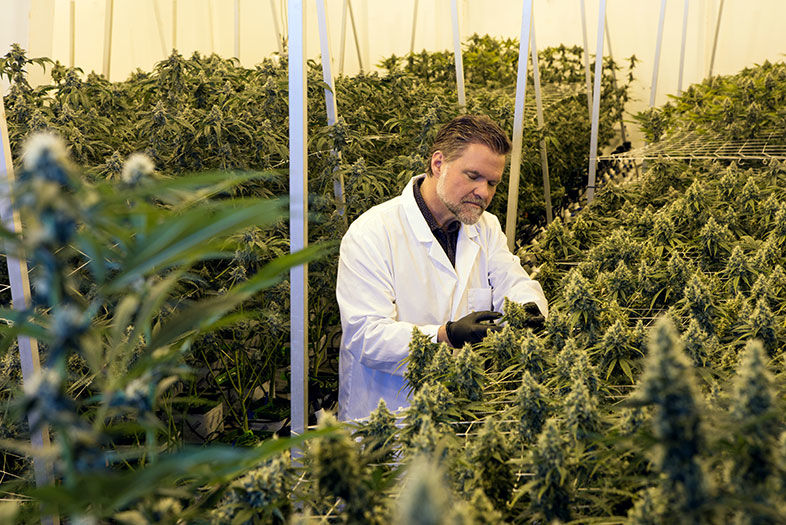
Green Rush: Inside San Diego’s Emerging Cannabis Industry
Lincoln Fish was anti-marijuana until a friend suggested he research the medical benefits. Now he owns OutCo in El Cajon, the largest cultivation operation in SoCal.
Nixon created the infamous Shafer Commission to help him decide where to put marijuana. Made up of political conservatives, the commission seemed sure to vilify weed. It didn’t. After a year of study, it released its report, “Marihuana: A Signal of Misunderstanding,” which recommended an end to prohibition. In 1973, Nixon ignored their findings and classified marijuana Schedule I, as dangerous as heroin and LSD. Some states had read the report for themselves, and decriminalized the drug. Still, arrests skyrocketed.
From 1972 to 1990, marijuana arrests averaged 400,000 per year. There was also a racial element to the war against marijuana. Anslinger infamously claimed, “Marijuana causes white women to seek sexual relations with Negroes.” Between 2001 and 2010, about 800,000 Americans were arrested every year on marijuana charges; a majority of them were nonwhite. In 1990, the arrests of nonwhite teenagers was 3,100; in 2010, it was 16,400. In the mid-2000s, about 40,000 people were in federal or state prisons on marijuana charges, most of them black men. Black men were four times as likely as white men to be arrested on pot charges.
So how’d we go from Reefer Madness to legalization? Medical marijuana happened. Soldiers reported it helped with PTSD. Cancer patients used cannabis to alleviate their nausea and increase their appetite. Harvard reported it helped reduce spasms in patients with multiple sclerosis. It reduces the intense eye pressure associated with glaucoma. Patients with epilepsy reported it prevented seizures (a GW Pharmaceuticals study proved that in 2017).
Gallup polls from the early 2000s show that only about one-third of America favored legalization. After reports of its health benefits, that number jumped to 44 percent in 2009. In 2013, 58 percent of Americans said it should be legalized. California legalized medical marijuana in 1996, and 19 other states plus Washington, DC, did the same by 2013.
In 2009, President Obama’s deputy attorney general, David Ogden, sent a memo to US attorneys advising them not to pursue federal charges against people whose marijuana usage complied with state laws. CNN’s top medical correspondent, Dr. Sanjay Gupta, wrote an article for Time that year called “Why I Would Vote No on Pot”—but in 2013, after spending six months studying the medical uses of marijuana, he reversed his stance in a CNN article titled “Why I Changed My Mind on Weed.” Regarding its classification as a Schedule I drug and its exaggerated harm, he explained: “We have been terribly and systematically misled for nearly 70 years in the United States, and I apologize for my own role in that.”
If Gupta could change his mind, so could the most vocal opponents—American parents. A 2017 study showed over 93 percent of Americans support medical marijuana, and 73 percent would oppose a federal crackdown.
“A few reasons for legalization,” says Chris Conrad, one of the country’s foremost cannabis expert witnesses: “It’s nontoxic. You don’t have any history of anybody ever dying from marijuana. It’s safer than alcohol or aspirin. You have a bigger chance of having a heart attack during sex. Also, I’d prefer to buy it from a store. It’s safer. And it’s going to create a lot of jobs.”
Currently, 29 states and the District of Columbia have legalized marijuana in some form. Colorado and Washington were the first states to allow nonmedical use, in 2012, and six more states have followed.
In 2014, Congress passed the Rohrabacher-Blumenauer amendment, barring the Department of Justice from using federal money to prosecute people who comply with state marijuana laws. As of press time, the amendment has not yet been renewed for 2018. And US Attorney General Jeff Sessions—a longtime antidrug advocate who famously said that “good people don’t smoke marijuana”—rang in the new year by rescinding the Ogden memorandum.
Still, despite the new administration’s stance on the drug, California remains the sixth largest economy in the world. That may not be a fight Sessions wants to pick.
“You don’t put the jack back in the box,” says Rachel Laing, a lobbyist for the San Diego–based United Medical Marijuana Coalition.
Even amid fear of federal intervention, business must go on.
The Grower
A few years ago, Lincoln Fish was anti-pot. Now he runs OutCo in El Cajon, the largest legal cultivation outfit in Southern California, and its associated dispensary. He had already created and sold a successful nutritional supplement business when a colleague paid him a visit.
“He told me he was getting into cannabis,” says Fish in his boardroom, overlooking his marijuana plants. “I said, ‘Are you are crazy? I’m not getting involved in drugs.’ I was a nerd through school and didn’t use the stuff. He said, ‘Go home and read about it.’ And sure enough, I was almost embarrassed that I was that out of touch and did not understand the hypocrisy involved with this.
“What really changed my mind was learning about the medicinal side. Wipe everything we think about it now, good or bad. If we found this plant in the Amazon tomorrow, it would be the greatest scientific find of our time.”
While giving a talk at a recent event, Fish ran into the head of the San Diego Police Department’s Domestic Violence Unit. “He said, ‘Take a guess what percentage of our cases involve alcohol.’ I said, ‘I dunno, 40?’ He said 70 percent. I said, ‘How many involved cannabis?’ He said none.”
OutCo opened as a medical marijuana dispensary and cultivation business in 2014. Through the front door you’re greeted by a security guard. Most dispensaries have one, because marijuana is a cash business. Since it’s not federally legal, and banks are federally insured, banks won’t touch the money.
Past a locked door is a clean, modern retail room. It looks like a Sephora. Budtenders assist clients at a glass case stocked with dried buds in various jars, which have names like Zskittlez, Girl Scout Cookies, and Chernobyl. There are tinctures (alcohol-based marijuana extracts) in flavors like peppermint and tangerine. There’s “Cannanut Oil,” a mixture of cannabis and coconut oil. A female sexual stimulant, OutCo Love Budder. There’s a range of products with just CBD, the non-psychoactive cannabinoid responsible for most of marijuana’s health benefits.
“We just came out with this,” says communications director Virginia Falces. It’s a cannabis suppository to help ease menstrual cramps. She tells of a family member who suffered from terrible cramps, and says this has been the only thing that works.
Fish takes me beyond the dispensary into the cultivation operation. I meet Allison Justice, vice president of cultivation. She’d never grown marijuana before coming to OutCo—she’d spent her whole life studying carnations, and has a doctorate in plant and environmental science.
OutCo is full of PhDs. German chemical scientist Markus Roggen runs their extraction program, in which machines use CO2 and pressure to extract the cannabis oil from the flowers. “The average yield is 70 percent,” says Fish. “Markus has gotten 90 percent.”
When staffing OutCo, Fish didn’t want longtime marijuana vets. He felt they had wisdom, but not science. For instance, after the plants are harvested, they need to be dried for 10–12 days. Fish asked some old-school growers how they knew it was perfectly dried. “They said, ‘Well, hold up the stem, bend it, and listen for the snap.’ That’s not really scalable science, guys.”
Most marijuana experts would say that OutCo’s harvest isn’t ideal, since it’s grown indoors, which wastes resources. The company is working on a 103,000-square-foot greenhouse project on Native American land, but the new legislation has made that trickier. On the other hand, here in El Cajon, they use zero artificial products. The most popular method of cannabis extraction is ethanol-based, but OutCo uses a blood centrifuge, which increases yield without having to use ethanol. Fish opens a fridge that’s filled with mason jars of extract. Picking up one that’s about half full, he says, “That’s about $20,000 worth.”
He points out the window of the boardroom. “See those things hanging on the rafters that look like wristwatches? Those are cameras. Those feed into a software program. The software can take the image, with heat and other signatures, and look for nutrient deficiencies, watering issues. The researchers behind this came out from Colorado to us because they couldn’t find anyone in Colorado who had enough of a scientific team to do it.”
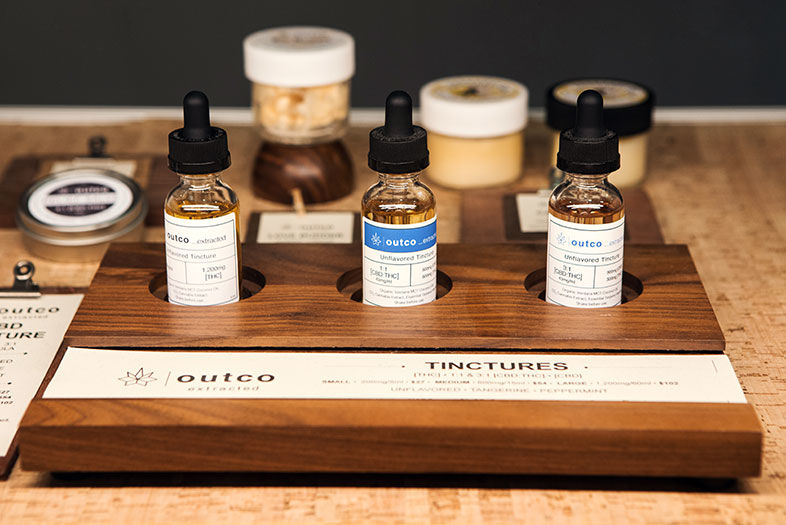
Green Rush: Inside San Diego’s Emerging Cannabis Industry
It’s not just “bud.” Dispensaries are using extracts and tinctures to develop all sorts of products of varying concentration and potency.
Allison Justice also discovered a flaw in Colorado’s testing practices. A major argument for legalizing weed is that it’ll be safer. For instance, there’s a nasty fungicide called Eagle 20 used by some black-market producers. When combusted, it turns into hydrogen cyanide. Testing should ensure that no harmful pesticides or microbes are present.
“Allison started seeing these crops in Colorado that were testing ‘zero microbes,’” says Fish. “We have microbes on our skin. Microbes are everywhere. It’s just impossible.”
“None of the growers would tell me how they did this,” Justice adds. “Finally someone told me—you take your own sample, and prior to taking it to the laboratory for testing, you put it in the microwave.” Fish mentioned this to Colorado testing authorities, who changed the law. Now the lab must go to the cultivator and choose a sample. The authorities also began doing DNA tests on the cannabis. “So even if you had bud that had E. coli on it, and you put it in the microwave,” Justice explains, “the E. coli will show up on the DNA tests.”
Former NFL star Ricky Williams, who famously used marijuana to deal with his social anxiety, is working with OutCo to develop his own line of cannabis. He came to the El Cajon laboratory to work with the scientists. “He’s actually getting his doctorate in Chinese herbal medicine,” says Fish.
Business-wise, OutCo has a problem, as do others who’ve set up in the area. They chose El Cajon because it was the only place they could legally grow cannabis at the time. But last year, while the city legalized adult use, the county voted to ban new cultivation and retail in unincorporated areas. OutCo and others are suing the county.
“We had the three votes we needed and then Kristin Gaspar beat Dave Roberts for the seat,” explains Fish. “She told us at a meeting at a fundraiser, ‘I have no problem with medical marijuana, sounds great.’ And then she and Dianne [Jacob] made some backroom deal and voted against us. Everyone was floored.”
Asked for comment, Gaspar’s communications director, Itica Milanes, replied, “The supervisor’s position on medical marijuana is well established. Any decisions pertaining to it before the board have been strictly a land use decision and don’t involve the merits of medical marijuana.”
Fish says he’s not concerned. “We’re getting involved in two of the supervisor contests. We have vested rights; we should be able to do what we were planning on doing originally under the ordinance. The other guys did not buy multimillion-dollar buildings in the area just to be able to open a tiny dispensary. They bought it so that they can cultivate.”
For now, Fish and OutCo are continuing as a medical-only operation. Clients must have their medical card, which—incidentally—takes about 10 minutes to acquire online. They’ll be opening an adult-use dispensary in Sorrento Valley soon, with plans for five or so more in the state. They’re also working on two cultivation centers in Long Beach.
But OutCo’s long-term goal isn’t dispensaries. It’s science. “Everything we do has been tested to the nth degree,” he says. “We’re doing shelf stability studies. Nobody can tell you how long flower stays good on a shelf before it degrades. A big part of making cannabis is curing, which makes the flower smell good. When we age wine, we know exactly what happens from a molecular level. But nobody can tell you what happens to cannabis.
“The question is, who’s going to spend the money on real science? Well, we are. We know the future of this business is going to be the people who have the quality, consistency, safety, and efficacy. That’s a game we can win with science.”
Burning Questions
What you need to know about San Diego’s new cannabis laws
Who can purchase marijuana?
Anyone with a valid government ID proving they are 21 or older.
Do I need a medical card?
No, though some dispensaries are still licensed only for medicinal use. Check before you go.
Can I use a credit card?
Don’t count on it. Cash only. Nearly all have ATMs on site.
Can I use cannabis in public?
No. $100 fine. Home use only, unless a local ordinance allows it. Can’t smoke within 1,000 feet of a school, daycare center, or youth center while kids are there. If you’re caught smoking at a place where tobacco is also illegal (in a restaurant, near schools, etc.), $250 fine.
How much can I legally carry?
Up to an ounce of flower/bud, or eight grams of concentrate (hash, tincture, oil, dabs, etc.)
Can I drive with it in my car?
You’re allowed to drive with cannabis in a closed package. Police can cite you for an “open container.” However, you can drive with an open package in the trunk.
Am I allowed to grow it?
Yes. Up to six plants.
Can my employer still drug test me?
Yes. Know your workplace’s rules regarding cannabis.
The Retailers
“I’m in Florida making a presentation to high-net-worth investors,” says Will Senn. “We’re in the middle of a big raise for Floris Capital Management.”
Senn’s story is the story of legalized marijuana in San Diego. He grew up in San Francisco’s East Bay, which is ground zero for California’s cannabis industry. He worked for dispensaries in high school before moving to San Diego and opening his own in 2009. At the time, the laws were nonexistent, or at the very least gray.
After the passage of Prop 215 in 1996 and subsequent legal battles, San Diego started accepting applications for medical marijuana dispensaries. They boomed.
“At one point, there were over 200 dispensaries,” Senn says. “But the city council started to pass an ordinance that was going to shut everyone down. Well, that wasn’t going to work. I started the Patient Care Association of California, and Citizens for Patient Rights. We ran a referendum. The city council ended up repealing that ordinance.”
I spoke with Senn in December. As the owner of Urbn Leaf, the largest dispensary group in San Diego, he was on the precipice of history. “We’re 30 days away from the fifth largest economy in the world opening its market,” he says. “It’s exciting, and nerve-racking. We don’t know if we’re going to have lines around the corner, or if we already tapped out our client base.”
Rachel Laing, the cannabis lobbyist, predicts the former. Especially now that, under the law, all people will need is an ID proving they’re at least 21. “I know a lot of professionals who partake, but would never get a card because they don’t want that on their record. I think sales are going to go through the roof.”
At least initially, Laing was right. On January 1, the lines at San Diego dispensaries were massive. Opening day sales at Urbn Leaf were four times the norm. I visited them on the 2nd, a Monday. There was no line, but the place was significantly more packed than my previous visits before legalization.
Urbn Leaf, along with OutCo’s Outliers Collective and other dispensaries like Torrey Holistics in Sorrento Valley, represents the new face of marijuana. It’s their job to rebrand an industry that’s long been stereotyped as the realm of burned-out hippies, do-nothings, couch-dwellers, late-night pizza eaters, and college kids getting as high as humanly possible. Torrey Holistics looks like a warmer Apple store, clean and modern and high-end. At Urbn Leaf, a big sign reads “A Feel Good Drug Boutique.” The interior could be a hip craft-beer tasting room.
“We wanted a modern, industrial concept,” says Senn. “We wanted to embrace the stigma of cannabis and redirect it. Our message is that this shouldn’t be a Schedule I drug. It’s great for you, and it should be legalized. We want anyone who comes in, whether they’re 85 or 21, to feel comfortable. A lot of older clientele, well into their 70s and 80s, come in because it’s a very welcoming atmosphere. I think that clientele has always been in the cannabis market, but they only choose where they go based on the comfort. We analyzed everything from the music in the waiting room to the smell in the lobby. There is a specific scent we developed for when you walk in.”
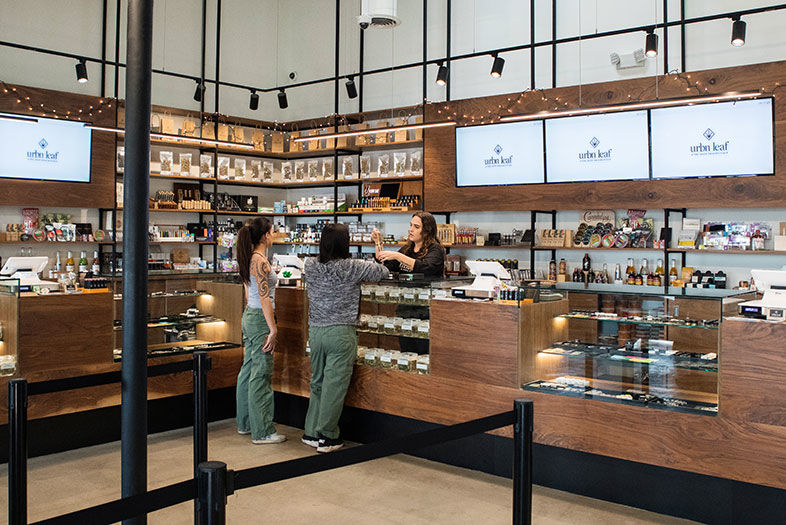
Green Rush: Inside San Diego’s Emerging Cannabis Industry
Urbn Leaf in Bay Park is designed in a modern style, showcasing products like Legal beverages, FlavRx chocolates, and various vaporizing oils fortified with cannabis.
Torrey Holistics marketing director Ruthie Edelson also designed their brand to be all-inclusive. “I didn’t want it to be a bunch of pictures of marijuana,” she explains. “I wanted a place where you could feel at ease, to reach the baby boomers and people who used to do it, but grew up when Nancy Reagan was saying no to drugs and it got a bad rap. The people who think, ‘What will my kids think?’ Truth is, their kids are doing it, too. We want to bring a peace of mind. Marijuana is medicine, it’s legal, and we’re safe.”
Urbn Leaf has multiple buses downtown wrapped with their logo. Its Bay Park location is set to undergo a massive expansion and redesign, and a third location is set for Middletown. Senn’s biggest concern is money. Being cash-only makes everyone in the industry—retail clerks, drivers, everyone—a huge target for robbery. Senn has purchased an old Wells Fargo bank vault, which is a secure but impermanent solution. If the city and the state want to collect the massive tax revenue from this industry, they’ll have to ensure its safe storage and transportation.
“The way you make it safe is you give me a bank,” Senn says. “I’m hopeful that John Chiang can help us. He’s talking about creating a state bank specifically for cannabis.”
Chiang, California’s state treasurer, spearheaded a working group that studied how to help cannabis businesses open bank accounts and pay their taxes. I spoke with Chiang, who speaks like a state treasurer. To be honest, I didn’t understand a lot of it. But I understood this:
“We’re addressing this on multiple fronts,” he says. “We’re not going to have a final disposition until Washington, DC, steps up and provides leadership in the cannabis space, whether it’s banking, criminalization, or regulatory actions. We’re looking at the use of couriers. Who wants to be at risk carrying $200,000 to commit your obligation to the tax board or Employment Development Department? If we use an armed courier, the technical recipient would be the state. Other businesses could be participating in this program, so it would not just be cannabis dollars. Some financial businesses were concerned that they would only get cannabis dollars. Now it’s the money of the state. And these are dollars that come from multiple, varied businesses.”
The other concern is the black market. Because legal businesses are paying taxes and licensing fees, their costs are higher. Someone growing illegally could easily undercut legitimate businesses on price. On the first day marijuana became legal in Colorado, Weed the People author Barcott witnessed a black market dealer working the line at a dispensary. A lot cheaper and no waiting, the dealer bragged.
“The city attorney and SDPD have been pretty aggressive on any unlicensed cannabis operation,” says Senn, who compliments how the city has handled legalization. “They’ve been holding up their end of the bargain. Our product can’t compete because of compliance, overhead, taxes.”
The crackdown on the black market is helped by the fact that most newly legal cannabis outfits know who runs the black market. They’ve been swimming in the same circle for decades.
Senn is optimistic the state and city will help legal marijuana businesses survive. The monetary incentive helps. “If the projections are right,” he says, “this will be bigger than the wine industry.”
The Makers
In 2010, Jena Perez used her mother’s recipe to start her artisanal toffee business, SweetBricks. She did well, featured in this magazine and on Food Network. Now she’s stopped selling SweetBricks.
“Jetty Extracts approached us in 2016 and asked if we wanted to put their cannabis extract in our product,” she explains. “My partner Darlene and I had no experience. I never thought I’d get into edibles. We did a very public campaign about it. We were one of the first mainstream food companies to jump into edibles.”
Their new, cannabis-infused version is called Mind Tricks Toffee. There was a learning curve. Cannabis extract has the consistency of molasses, so they had to reconfigure the recipe. Each Mind Tricks Toffee includes a 10-milligram dose, and at first, Perez would have to break down a 100-milligram package of extract by hand.
“I was terrified of adding too much,” she said. “I’m terrified of edibles. Everyone is. You’ve heard the stories. But now it comes to us in 10 milligram packages. People can finally enjoy it. Soccer moms are hitting me up and say they just want a tiny dose instead of their glass of wine at night.”
The feedback was incredible, as was the profit. While she sold a 2-ounce bag of SweetBricks for $2, the same amount of Mind Tricks sells for $15. That money helps her family, especially her mother, who has multiple sclerosis and lives with Perez. Every night, she gives her mom a dose of CBD, which improves her circulation and helps her sleep.
“I remember going to my mom and asking her if it was okay to change her recipe,” she says. “She knows I’m not really into weed. She said, ‘I trust you, and you gotta do what you need to do.’”
Now Mind Tricks production is about 10,000 packages per month. In September, Rolling Stone featured Perez in their story “Weed Warriors: Meet Six Women Shaping the Cannabis Industry.” After a year and a half of making Mind Tricks, she finally tried her own product three months ago. “I tried it for the first time with Snoop Dogg at a party,” she says. “It was insane. Like, ‘Who am I?’”
“A lot of hospitality veterans are getting into the space,” says Ted Glennon, former sommelier at the Hotel del Coronado. One of the city’s top pastry chefs is (anonymously) behind the brand Kaneh Co. Entrepreneur Marie Tahan Daniels operates San Diego’s Closed Door Supper Club, a pop-up dinner series with local chefs that incorporates cannabis. There’s a whole market of CBD extracts for pets. At OutCo, Virginia Falces tells me stories of clients whose pets are entering the late stages of life. “I can’t tell you how many people come back in after giving their dog or cat CBD and say, ‘Oh my god, he ran! He hasn’t run in years.’” One local company, Cannimal, specializes in “ailment-specific animal products combining the healing power of adaptogenic herbs and CBD.”
Then there’s the whole new industry of “weedings.” Weddings with weed. Leslie Monroy owns Flowers on Flowers, which claims to be “California’s first and only team of medical cannabis florists.” She says, “I’ve been growing cannabis since I was in high school. Weddings just came out of nowhere. Some will do personalized joints with a guest’s name on it and seating arrangement. A lot of people will do an open bud bar. You have your budtender, and usually have it off to the side. It’s just like a regular bartender. You have to judge your crowd, know when someone’s had too much, not enough. It’s lots of fun. You get an older crowd who comes over and is just curious.”
She’ll often place marijuana in the floral arrangements at the table, or in the bride’s bouquet. “They’ll do toke-and-toasts,” she says. “At the beginning of the toast, the groomsmen will stand up and say, ‘You all have a joint at your table. Light it now.’ And then they’ll give the speech.”
Finding venues willing to host a weeding isn’t easy, but Monroy’s tapped a few. The biggest issue for marketing her business is that most clients don’t want photos taken. The stigma still exists, but she expects that will change with legalization.
Monroy charges an extremely low rate, because all of her weeding work is for charity—specifically Canines for Disabled Kids, which helps children get service animals. “I can do your whole wedding party for about $300,” she says. “A lot of florists are mad at me. I’m not trying to buy a Lamborghini. I’m just trying to get my business out there.”
She’s not the only one. The green rush is on.
Treat Cred
We asked cannabis experts for their favorite edibles
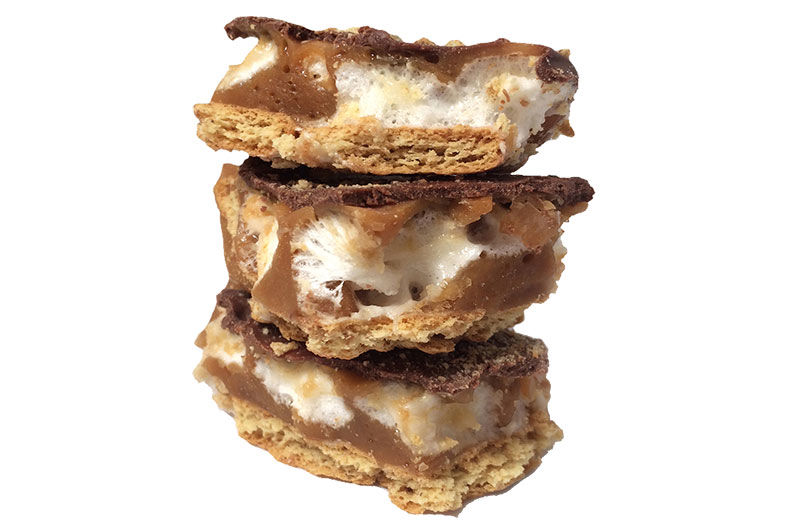
Green Rush: Inside San Diego’s Emerging Cannabis Industry
Mind Tricks Toffee (pictured) includes 10 milligrams of cannabis added to a beloved family recipe.
Flav has a huge roster of treats, and is best known for their gummies and chocolates.
Beboe emphasizes sleek branding for its bespoke vaporizers and candies.
Kaneh has a well-known (but anonymous) pastry chef behind its brownies, cookies, and bars.
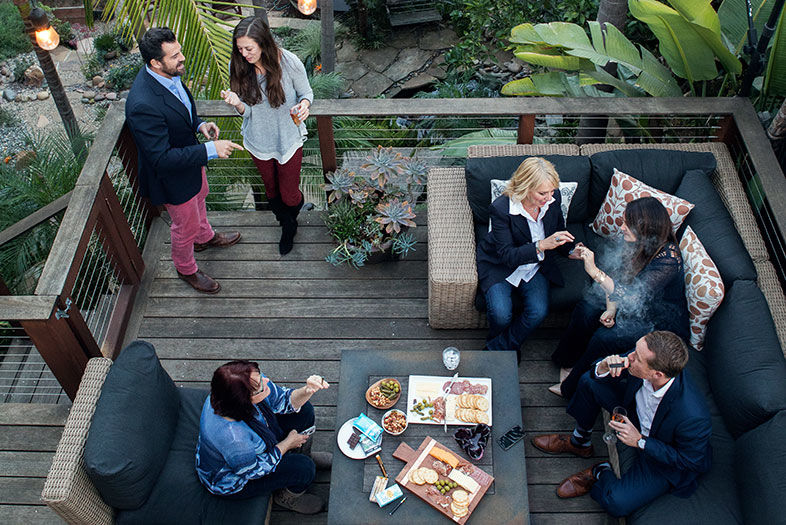
Green Rush: Inside San Diego’s Emerging Cannabis Industry
At a home in Mission Hills, these professionals and medical patients challenge the old stereotype of marijuana users.

